Allergy Treatment Market Size
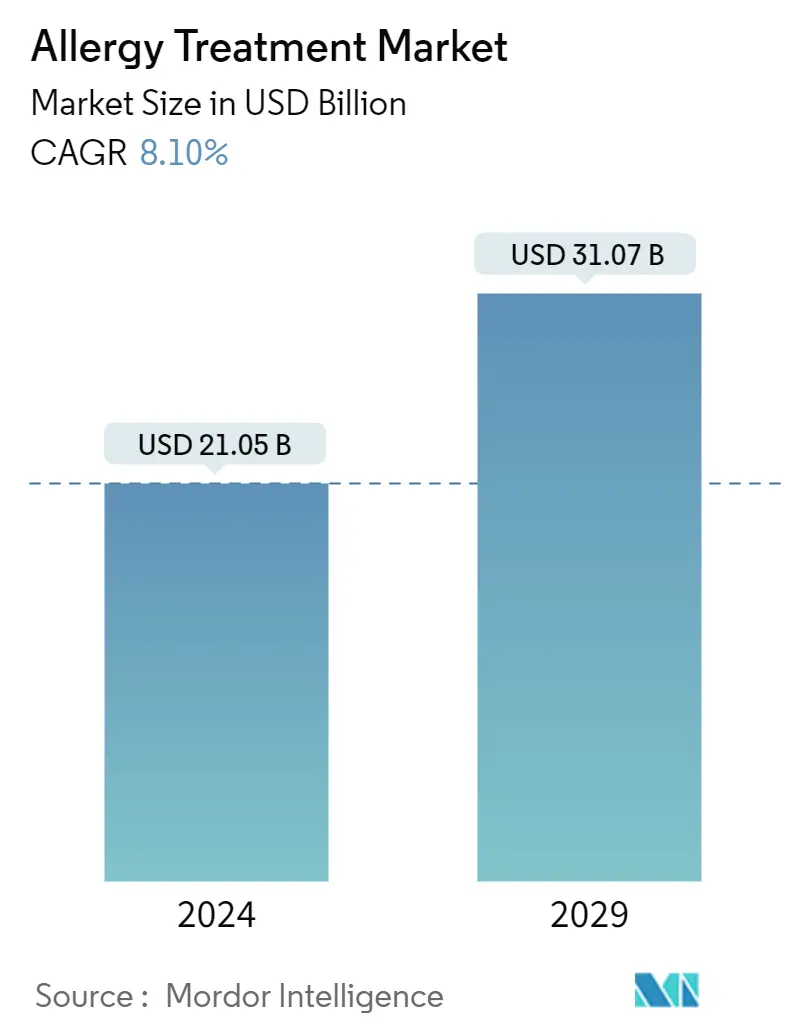
| Study Period | 2024 - 2029 |
| Market Size (2024) | USD 21.05 Billion |
| Market Size (2029) | USD 31.07 Billion |
| CAGR (2024 - 2029) | 8.10 % |
| Fastest Growing Market | Asia Pacific |
| Largest Market | North America |
Major Players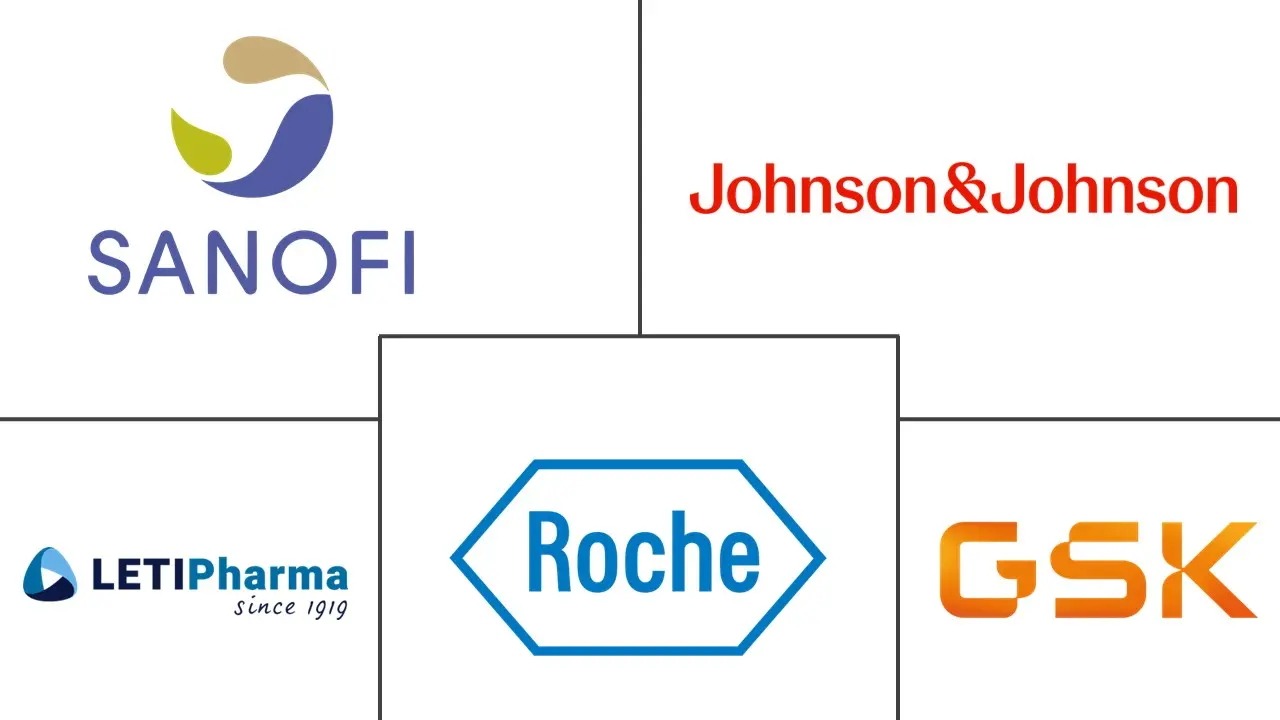
*Disclaimer: Major Players sorted in no particular order |
Allergy Treatment Market Analysis
The Allergy Treatment Market size is estimated at USD 21.05 billion in 2024, and is expected to reach USD 31.07 billion by 2029, growing at a CAGR of 8.10% during the forecast period (2024-2029).
The increasing prevalence of various kinds of allergies, the rising investment in the development of novel allergic therapies, and the growing importance of self-medication are the major factors accelerating the market's growth. Allergies occur due to the hypersensitivity of the immune system to foreign substances. Allergic conditions are one of the most common health issues affecting the population in the United States. For instance, in 2023, the Asthma and Allergy Foundation of America (AAFA) reported that more than 100 million Americans are affected by various types of allergies yearly. According to the same report, about 26% of adults and 19% of children in the United States were diagnosed with seasonal allergic rhinitis.
Furthermore, according to the study published in the National Library of Medicine in October 2023, across continents, the values of asthma prevalence ranged from 3.44%, 3.67%, 4.90%, 5.69%, 8.29%, and 8.33% in Asia, Africa, South Africa, Europe, North America, and Oceania, respectively. Thus, the growing prevalence of allergies is expected to increase demand for their treatment, thereby boosting the market's growth.
With the increase in allergic reactions, there are rising investments worldwide to develop novel treatments. For instance, in October 2023, Aiolos Bio, a newly launched startup with an asthma drug in clinical trials, announced that it raised USD 245 million in Series A funding. Aiolos plans to use the funds for phase II clinical trials of its lead drug candidate, AIO-001, for moderate-to-severe asthma patients. In addition, in January 2024, GSK initiated a deal to acquire Aiolos Bio for USD 1.4 billion to access the development of Aiolos' phase II-ready AIO-001 asthma treatment.
Furthermore, in January 2024, Aravax, a startup firm, raised USD 66 million in a funding round to develop a novel peanut allergy treatment. Aravax is a clinical-stage biotechnology company focused on revolutionizing food allergy treatment through its product, PVX108. Hence, such huge investments are expected to drive the market studied over the forecast period.
However, the growing preference for low-cost biosimilars and lack of awareness regarding allergy immunotherapy can hamper the market's growth.
Allergy Treatment Market Trends
The Subcutaneous Immunotherapy (SCIT) Segment is Expected to Hold a Significant Share in the Market Over the Forecast Period
Subcutaneous immunotherapy (SCIT) involves administering escalating doses of antigen via one or more subcutaneous injections weekly for the treatment of various allergic conditions affecting the nose, eyes, and lungs.
SCIT preparations are one of the most innovative treatment options in the immunotherapy of allergic diseases. For instance, according to the Journal of Allergy and Clinical Immunology published in January 2024, subcutaneous immunotherapy (SCIT) is a long-established treatment option for allergic rhinoconjunctivitis. Furthermore, according to an article published in Allergies in February 2022, SCIT was used for cases of severe allergic rhinitis(AR) with symptoms that were not adequately controlled by drugs, when the side effects of drugs limit the treatment options, or where the aim was to cure the disease rather than symptomatic relief of AR. Hence, the various advantages of SCIT over other allergic treatment options are expected to increase the adoption of SICT, which will ultimately drive the revenue of the segment during the forecast period.
The innovative launch of immunotherapy products is also expected to drive the segment during the forecast period. For instance, in February 2024, the US Food and Drug Administration approved Xolair (omalizumab) injection for immunoglobulin E-mediated food allergy in adults and children to treat allergic reactions (Type I) and reduce the risk of anaphylaxis reaction that could occur with accidental exposure to one or more food items. Hence, such product approvals are also expected to drive the growth of the segment during the forecast period.
Thus, factors such as various advantages of SCIT and increasing immunological product approvals are expected to accelerate the market studied over the forecast period.
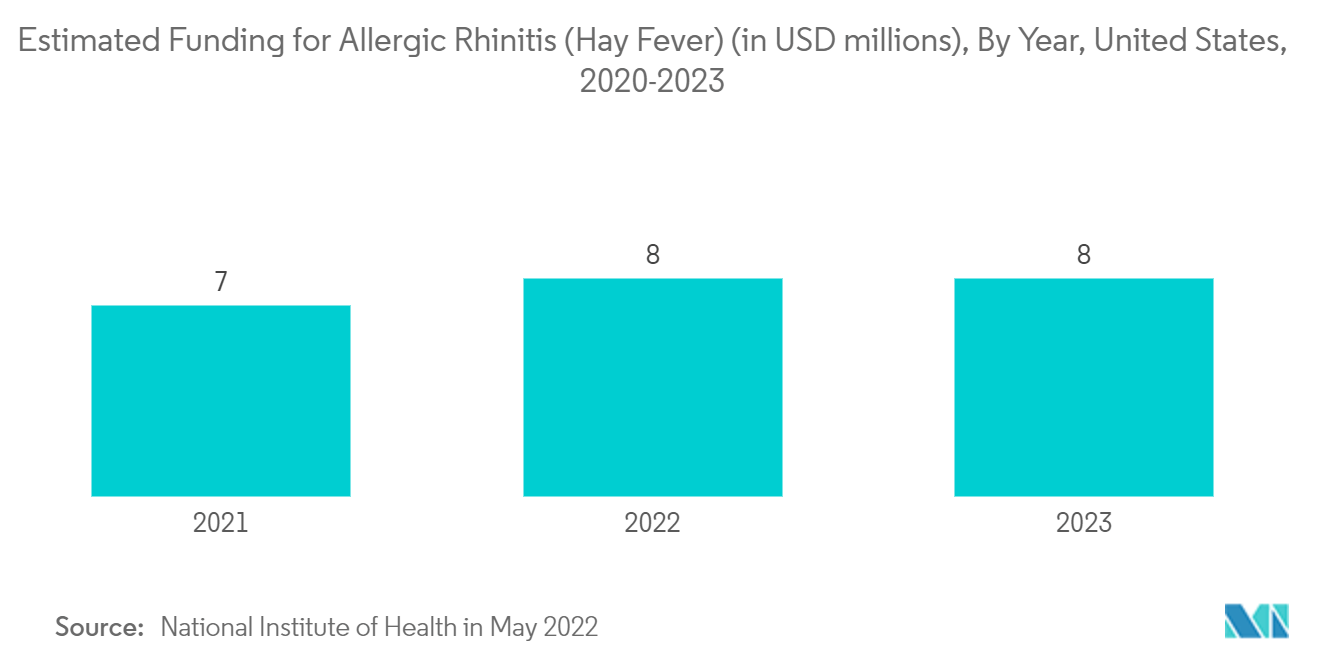
North America is Expected to Hold a Significant Share in the Market Over the Forecast Period
North America is expected to hold a significant market share during the forecast period. This is mainly due to the increase in allergy-related research activities and the rising prevalence of allergies.
The rising prevalence of allergies in North America is expected to drive the market studied. For instance, the Health of Canadians report released in September 2023 stated that around 8.7% of Canadians aged 12 and older were diagnosed with asthma, and it was most prevalent among people aged 12 to 17.
Similarly, according to the Global Asthma Report 2022, the prevalence of asthma diagnosed by a doctor was 5.4% and 6.6% in children and adolescents, respectively, in 2022. These results indicate that the prevalence of asthma symptoms has increased in the past 15 years. Hence, the rising prevalence of asthma among the young population in North America is expected to drive the market.
Furthermore, growing strategic initiatives, such as product launches by companies, are also propelling the allergy market in North America. For instance, in November 2023, the US Food and Drug Administration granted fast-track designation for ADP101, an oral immunotherapy (OIT) that was developed by Alladapt Immunotherapeutics. Hence, such product launches are expected to drive the market during the forecast period.
Thus, factors such as the rising prevalence of allergy diseases, increasing government spending on allergy disease treatment, and increasing product launches in North America are expected to drive the market studied during the forecast period.
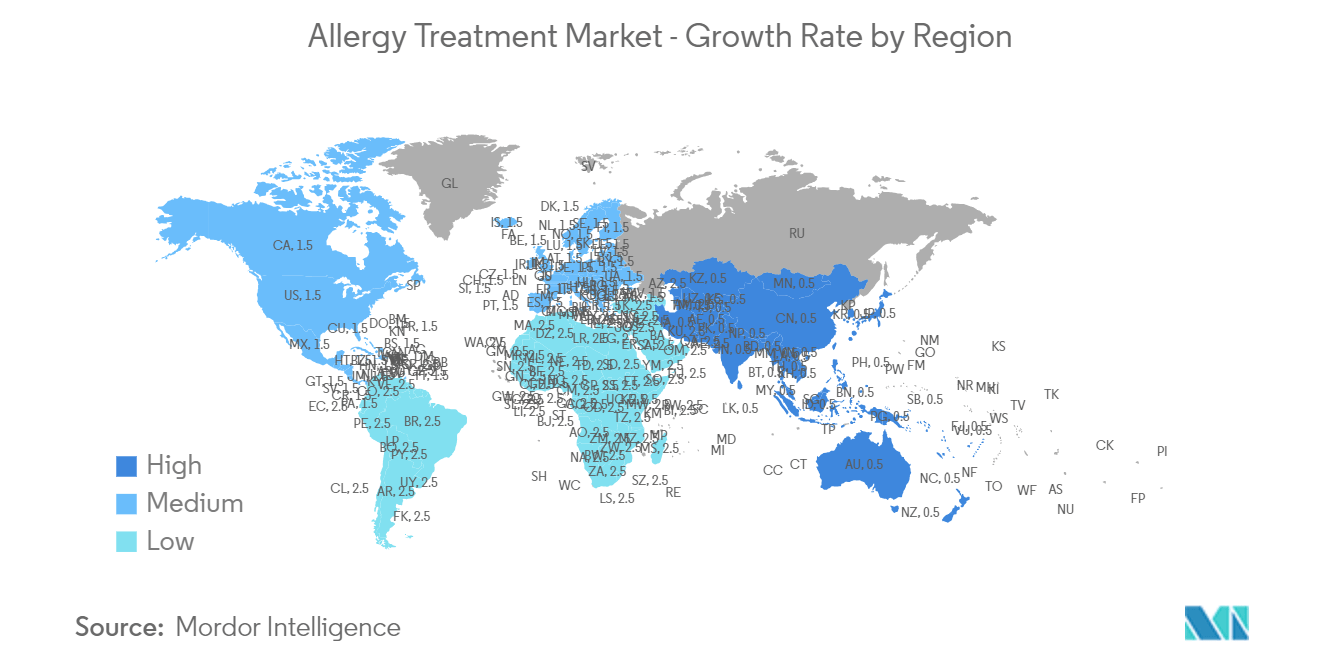
Allergy Treatment Industry Overview
The allergy treatment market is fragmented due to the presence of several international and local market players. Most allergy treatment products are manufactured by key global players. With increasing funds for research and development and better distribution systems, the market leaders are establishing their positions in the market. Some of the market players are Johnson & Johnson, Sanofi, GlaxoSmithKline, F. Hoffmann-La Roche Ltd, and Leti Pharma.
Allergy Treatment Market Leaders
-
Johnson & Johnson
-
Sanofi SA
-
GlaxoSmithKline PLC
-
F. Hoffmann-La Roche Ltd. (Genentech Inc.)
-
Leti Pharma
*Disclaimer: Major Players sorted in no particular order
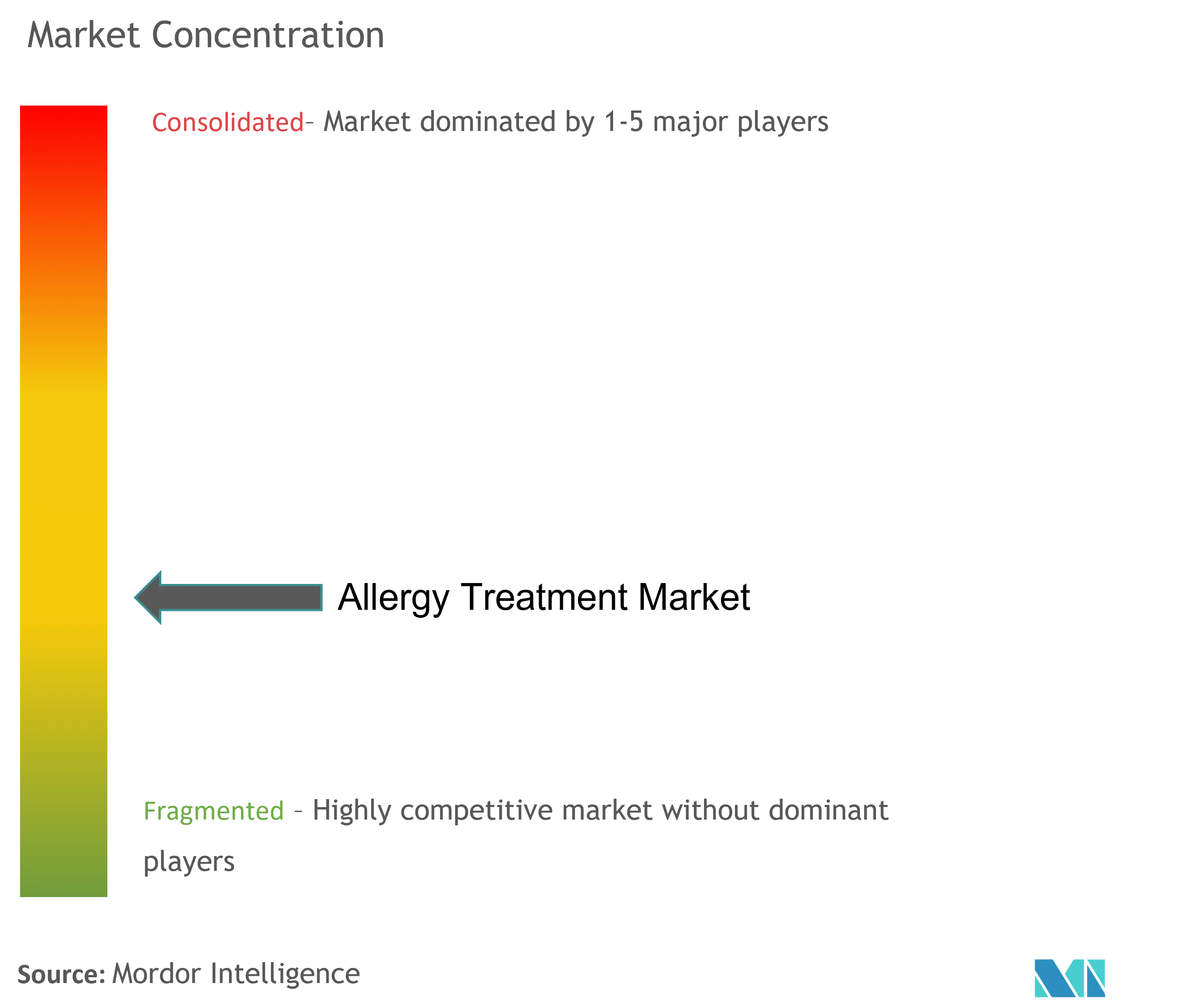
Allergy Treatment Market News
- November 2023: The United States Food and Drug Administration approved fast-track designation for Alladapt Immunotherapeutics’ IgE-mediated multi-food oral immunotherapy, ADP101, based on Phase I/II data.
- November 2023: Aimmune Therapeutics Inc. received approval for PALFORZIA from the US Food and Drug Administration to treat allergic reactions like anaphylaxis that may occur with accidental exposure to peanuts.
Allergy Treatment Market Report - Table of Contents
1. INTRODUCTION
- 1.1 Study Assumptions and Market Definition
- 1.2 Scope of the Study
2. RESEARCH METHODOLOGY
3. EXECUTIVE SUMMARY
4. MARKET DYNAMICS
- 4.1 Market Overview
-
4.2 Market Drivers
- 4.2.1 The Increasing Importance for Self-medication
- 4.2.2 Rising Incidence of Food Allergies Worldwide
- 4.2.3 Rising Investments by Manufacturers in the Development of Novel Allergic Treatments
-
4.3 Market Restraints
- 4.3.1 Rise in Preference Toward the Use of Biosimilars
- 4.3.2 Low Awareness of Allergy Immunotherapy (AIT) Among Patients
-
4.4 Porter's Five Forces Analysis
- 4.4.1 Threat of New Entrants
- 4.4.2 Bargaining Power of Buyers/Consumers
- 4.4.3 Bargaining Power of Suppliers
- 4.4.4 Threat of Substitute Products
- 4.4.5 Intensity of Competitive Rivalry
5. MARKET SEGMENTATION (Market Size by Value - USD)
-
5.1 By Type
- 5.1.1 Eye Allergy
- 5.1.2 Rhinitis
- 5.1.3 Asthma
- 5.1.4 Skin Allergy
- 5.1.5 Food Allergies
- 5.1.6 Other Allergies
-
5.2 By Treatment
- 5.2.1 Anti-Allergy Drugs
- 5.2.1.1 Antihistamines
- 5.2.1.2 Corticosteroids
- 5.2.1.3 Decongestants
- 5.2.1.4 Other Drugs
- 5.2.2 Immunotherapy
- 5.2.2.1 Sub-cutaneous Immunotherapy (SCIT)
- 5.2.2.2 Sub-lingual Immunotherapy (SLIT)
-
5.3 Geography
- 5.3.1 North America
- 5.3.1.1 United States
- 5.3.1.2 Canada
- 5.3.1.3 Mexico
- 5.3.2 Europe
- 5.3.2.1 Germany
- 5.3.2.2 United Kingdom
- 5.3.2.3 France
- 5.3.2.4 Italy
- 5.3.2.5 Spain
- 5.3.2.6 Rest of Europe
- 5.3.3 Asia-Pacific
- 5.3.3.1 China
- 5.3.3.2 Japan
- 5.3.3.3 India
- 5.3.3.4 Australia
- 5.3.3.5 South Korea
- 5.3.3.6 Rest of Asia-Pacific
- 5.3.4 Middle East and Africa
- 5.3.4.1 GCC
- 5.3.4.2 South Africa
- 5.3.4.3 Rest of Middle East and Africa
- 5.3.5 South America
- 5.3.5.1 Brazil
- 5.3.5.2 Argentina
- 5.3.5.3 Rest of South America
6. COMPETITIVE LANDSCAPE
-
6.1 Company Profiles
- 6.1.1 ALK-Abello AS
- 6.1.2 AbbVie Inc.
- 6.1.3 Allergy Therapeutics
- 6.1.4 Bausch Health Companies Inc.
- 6.1.5 Alembic Pharmaceuticals Limited
- 6.1.6 F. Hoffmann-La Roche Ltd
- 6.1.7 Nicox SA
- 6.1.8 GlaxoSmithKline PLC
- 6.1.9 Johnson & Johnson
- 6.1.10 Leti Pharma
- 6.1.11 Novartis International AG
- 6.1.12 Sanofi SA
- 6.1.13 Teva Pharmaceutical Industries
- *List Not Exhaustive
7. MARKET OPPORTUNITIES AND FUTURE TRENDS
** Subject To AvailablityAllergy Treatment Industry Segmentation
Allergy is a condition in which the immune system reacts abnormally to a foreign substance. Allergy treatment involves drugs and therapies that reduce the symptoms of allergies and help the immune system prepare for future encounters.
The allergy treatment market is segmented by type, treatment, and geography. By type, the market is segmented into eye allergy, rhinitis, asthma, skin allergy, and other allergies. By treatment, the market is segmented into anti-allergy drugs and immunotherapy. By geography, the market is segmented into North America, Europe, Asia-Pacific, Middle East and Africa, and South America). The market report also covers the estimated market sizes and trends for 17 countries across major regions globally. The report offers market size and forecast in terms of value (USD) for the above segments.
| By Type | Eye Allergy | |
| Rhinitis | ||
| Asthma | ||
| Skin Allergy | ||
| Food Allergies | ||
| Other Allergies | ||
| By Treatment | Anti-Allergy Drugs | Antihistamines |
| Corticosteroids | ||
| Decongestants | ||
| Other Drugs | ||
| By Treatment | Immunotherapy | Sub-cutaneous Immunotherapy (SCIT) |
| Sub-lingual Immunotherapy (SLIT) | ||
| Geography | North America | United States |
| Canada | ||
| Mexico | ||
| Geography | Europe | Germany |
| United Kingdom | ||
| France | ||
| Italy | ||
| Spain | ||
| Rest of Europe | ||
| Geography | Asia-Pacific | China |
| Japan | ||
| India | ||
| Australia | ||
| South Korea | ||
| Rest of Asia-Pacific | ||
| Geography | Middle East and Africa | GCC |
| South Africa | ||
| Rest of Middle East and Africa | ||
| Geography | South America | Brazil |
| Argentina | ||
| Rest of South America |
Allergy Treatment Market Research FAQs
How big is the Allergy Treatment Market?
The Allergy Treatment Market size is expected to reach USD 21.05 billion in 2024 and grow at a CAGR of 8.10% to reach USD 31.07 billion by 2029.
What is the current Allergy Treatment Market size?
In 2024, the Allergy Treatment Market size is expected to reach USD 21.05 billion.
Who are the key players in Allergy Treatment Market?
Johnson & Johnson, Sanofi SA, GlaxoSmithKline PLC, F. Hoffmann-La Roche Ltd. (Genentech Inc.) and Leti Pharma are the major companies operating in the Allergy Treatment Market.
Which is the fastest growing region in Allergy Treatment Market?
Asia Pacific is estimated to grow at the highest CAGR over the forecast period (2024-2029).
Which region has the biggest share in Allergy Treatment Market?
In 2024, the North America accounts for the largest market share in Allergy Treatment Market.
What years does this Allergy Treatment Market cover, and what was the market size in 2023?
In 2023, the Allergy Treatment Market size was estimated at USD 19.34 billion. The report covers the Allergy Treatment Market historical market size for years: . The report also forecasts the Allergy Treatment Market size for years: 2024, 2025, 2026, 2027, 2028 and 2029.
What are the key trends driving the Allergy Treatment Market?
The key trends driving the Allergy Treatment Market are a) Advancements in telemedicine, wearable devices, and allergy monitoring tools can potentially improve patient care and treatment outcomes b) Tailoring allergy treatments to individual needs and sensitivities based on allergy triggers and severity is a growing trend
Allergy Treatment Industry Report
The global allergy treatment market is witnessing substantial growth, driven by the rise in allergy incidences, such as asthma, rhinitis, and food allergies, alongside the advancement of new treatment technologies. This market is categorized by allergy types including eye, skin, food allergies, asthma, and rhinitis, and treatments like anti-allergy drugs and immunotherapy. Among these, Subcutaneous Immunotherapy (SCIT) stands out for its efficacy, expected to secure a significant portion of the market. Distribution channels facilitating these treatments span hospital pharmacies, retail pharmacies, and online pharmacies.
North America is the market leader due to its advanced healthcare infrastructure, high prevalence of respiratory diseases, and increasing adoption of immunotherapy. The Asia-Pacific region is rapidly growing, influenced by rising allergy cases, improving economic conditions, and a surge in awareness about advanced treatments. The market landscape is competitive, with allergy treatment companies vigorously investing in R&D and introducing innovative products.
Such activities aim to leverage growth prospects and meet the expanding needs of allergy sufferers globally. Market analyses suggest robust expansion with a detailed forecast outlook and historical review available in industry reports, which offer insights into market share, size, and revenue growth across different regions. For more comprehensive information, stakeholders can access these insights through a free report PDF download on allergy treatment market analysis.
The market size and market analysis are crucial for understanding the industry's future. Industry analysis and industry overview provide a detailed understanding of the market trends and growth rate. Market leaders and market research companies are continually updating market data to reflect the latest industry statistics and market predictions.
The industry outlook and market review offer a comprehensive look at market segmentation and market value. Industry information and industry reports are essential for stakeholders to stay informed about market forecast and market growth. The report example and report pdf provide a snapshot of the industry's current state and future prospects.
Research companies play a vital role in compiling industry research and market overview, ensuring that stakeholders have access to the latest market trends and market outlook. Industry sales and industry size are important metrics that reflect the market's overall health and potential for future growth.



